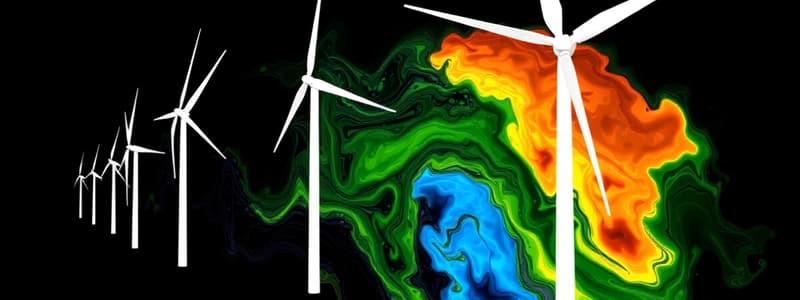Podcast
Questions and Answers
What is wind resource assessment (WRA)?
What is wind resource assessment (WRA)?
The discipline of estimating the strength of wind resources at a planned wind project site.
What are the primary outputs of wind resource assessment?
What are the primary outputs of wind resource assessment?
- Wind conditions (correct)
- Annual energy production (correct)
- Financial performance
- All of the above
The power in the wind is proportional to the square of the wind speed.
The power in the wind is proportional to the square of the wind speed.
False (B)
What are the primary sources of wind data?
What are the primary sources of wind data?
Name one commonly used wind resource estimation model.
Name one commonly used wind resource estimation model.
Match the following models with their descriptions:
Match the following models with their descriptions:
What does the frequency distribution measure in wind resource assessment?
What does the frequency distribution measure in wind resource assessment?
The wind speed is binned according to increments of ____ m/s.
The wind speed is binned according to increments of ____ m/s.
Which of the following is an example of a microscale model?
Which of the following is an example of a microscale model?
Flashcards are hidden until you start studying
Study Notes
Introduction to Wind Resource Assessment (WRA)
- WRA estimates wind strength at potential wind project sites.
- Key outputs include wind conditions and annual energy production, essential for financial performance modeling.
- Assessing wind resources is critical for determining wind project viability.
Importance of Wind Resource Assessment
- Wind power is proportional to the cube of wind speed, highlighting the significance of accurate assessments.
- Wind turbine procurement and foundation design rely on wind speed, shear, turbulence, and gust intensity data.
- WRA identifies and mitigates risks while maximizing potential project rewards.
Sources of Wind Data
- Onsite measurements provide localized wind data.
- Global networks of weather stations collect and disseminate wind speed and direction data.
- Numerical Weather Models offer long-term reanalysis data, with over 50 years of global atmospheric field analyses from NCEP and NCAR.
Resource Estimation Models
- Various models estimate wind speed using different data sources, including:
- Mesoscale Models
- Computational Fluid Dynamics (CFD) Models
- Microscale Models
- The generated wind data includes wind speed, shear, and direction.
Mesoscale Models
- Cover weather phenomena with spatial resolution from 20 to 2,000 km and temporal resolution from hours to days.
- Use reanalysis, elevation, and roughness data for input and apply boundary conditions for accuracy.
- Common examples include KAMM, MM5, and MC2; often combined with microscale models like WAsP for enhanced prospecting results.
Computational Fluid Dynamics (CFD) Models
- Used for modeling airflow in complex terrains and analyzing thermal effects.
- Provide insights into turbulence with high spatial resolution.
- Based on Reynolds-Averaged Navier-Stokes equations; popular software includes WindSim and 3D Wind.
WAsP as a Microscale Model
- Microscale models apply to areas around 100 km, suitable for assessing large wind farms.
- Wind Atlas Analysis and Application Program (WAsP) developed in the late 1980s and serves as a foundational tool for wind resource assessments.
- Frequently integrated with tools like WindPRO and WindFarmer.
Wind Resource Assessment Parameters
- Key assessment parameters include:
- Frequency distribution of wind speeds
- Wind power density for energy generation estimation
- Turbulence intensity evaluation
- Daily, monthly, and annual average wind speeds
- Wind Rose diagram for directional analysis
Frequency Distribution
- Essential for estimating energy production, depicting the percentage of time winds blow at different speeds.
- Wind speeds are categorized into bins to simplify analysis, e.g., speeds from 0-1 m/s binned as 1 m/s.
Studying That Suits You
Use AI to generate personalized quizzes and flashcards to suit your learning preferences.




